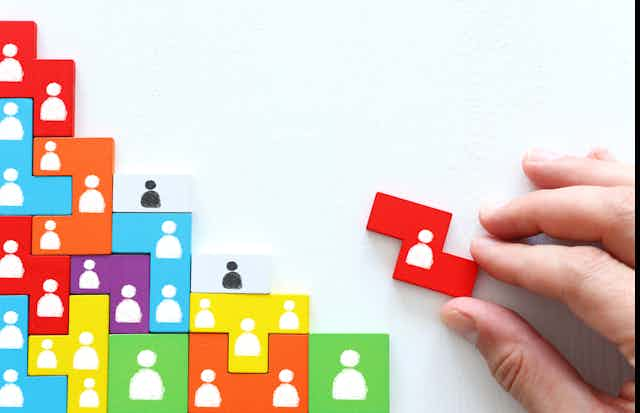As a biotechnology research scientist, I specialise in designing and creating “smart” implantable materials. These materials can control cell behaviour and enable us, for example, to grow new, replacement tissue for patients with diseased or damaged tissue, deliver drugs to a specific site in the body, or coat implantable medical devices so that the body doesn’t reject them.
The composition of these materials varies depending on what they’re used for. They could be based on hydrogels (soft, jelly-like materials that contain a lot of water), polymers (strong, flexible materials made of long chains of molecules) or something else entirely.
Our group was focused on seeing how new materials might be used to help rebuild the human voice box (larynx) after accidents or cancer treatment, for example. Changes to the larynx affect the way people breathe and speak, among other things, which can in turn lead to isolation and feelings of depression.
Restoring the complex workings of the voice box is challenging, and no ideal material presently exists. It must be strong enough to withstand repeated strain and movement, and avoid or resist attack by the immune system.
I explored materials that might fit this remit, focusing on whether they were robust enough and whether cells typically found in a healthy larynx would respond positively to these materials. Ultimately, I was able to manipulate polymer-based materials to create a potential basis for a larynx replacement device.
Lessons learned from the studies I conducted in the lab will inform how the material is combined with electronics into a device, testing of its movement and function, and could eventually lead to clinical trials to determine safety and efficacy.
Of course, any new technological solution to a medical problem must go through a rigorous process before being approved for use. So while my findings mark progress along the research pathway, it’s going to be some time before a potential voice box replacement device using these materials could be made available to patients.
Read more: Is every human voice and fingerprint really unique?
Discovering the human side of my research
Scientific projects typically require a combination of expertise, and in this project the team is composed of biologists, chemists, engineers, roboticists and clinicians.
But while I’ve had the opportunity to work with a broad range of scientists during my research career, my involvement in patient engagement has been limited, mainly because my work focuses on fundamental science, and I rarely leave the lab.
That changed in 2020 when I was introduced to Sound Voice, an organisation which brings together people with lived experience of voice loss, health-care professionals, biomedical researchers, academics, professionals in commercial technology and creative artists. Together, participants explore issues of voice loss and identity which they then translate into opera, music, live performances and installation pieces.
When I first heard about Sound Voice, curiosity led me to sign up. I didn’t have any particular expectations. After the first online session I attended – a flurry of singing, talking and break-out rooms – I sat staring at my computer screen. The participants’ voices, some barely above a whisper, replayed over and over in my head.
I could hear Tanja, who had her voice box removed one week after being diagnosed with a rare form of cancer behind her vocal cords.
I could no longer tell my two-year-old child to stop when there was immediate danger. I couldn’t read him a bedtime story. Those are things I miss about losing my voice.
I could hear Sara talk about her poem Can you Hear my Voice?, which captures her feelings on voice loss, identity and of wanting to be heard by others after losing the ability to speak.
I could hear Paul, who was starting to lose his voice due to motor neurone disease, and others who had started to lose their speech as a result of Parkinson’s disease.
These were the people who I was designing my materials for. While I may be focused on the function of a larynx, people like Tanja, Sara and Paul are grappling with how to find their place in a society that relies so heavily on speaking.
Read more: Curious Kids: how do voices come out of our mouths?
I thought about the materials I was developing: the science of producing noise, controlling the pitch, creating a device, the dimensions, implanting it into a patient, and the body’s response to the device. For the first time, I was able to see, albeit via my computer screen, the very end of the research pathway – the people themselves.

Scientific research is a cyclical process and while I may produce something that could one day be clinically relevant, the fact research in this area was required in the first place came from those patients. Of course, I knew all this. A large part of funding decisions for research proposals are informed by need.
But through this unique setup, I saw how I fit into the puzzle beyond just “doing science”. I now think: “What are the implications of my research beyond the immediate problem I’m trying to solve?” My experience with Sound Voice – particularly engaging with people who could one day be directly impacted by my research – has truly opened my eyes and ears, and given me a new perspective as I step into the lab and put on my lab coat.
Sound Voice is presenting performances at Kings Place in London on January 13-15, 2022 and May 27, 2022.

